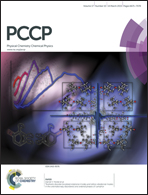Structure of H2Ti3O7 and its evolution during sodium insertion as anode for Na ion batteries†
Abstract
H2Ti3O7 was prepared as a single phase material by ionic exchange from Na2Ti3O7. The complete ionic exchange was confirmed by 1H and 23Na solid state Nuclear Magnetic Resonance (NMR). The atomic positions of H2Ti3O7 were obtained from the Rietveld refinement of powder X-ray diffraction (PXRD) and neutron diffraction experimental data, the latter collected at two different wavelengths to precisely determine the hydrogen atomic positions in the structure. All H+ cations are hydrogen bonded to two adjacent [Ti3O7]2− layers leading to the gliding of the layers and lattice centring with respect to the parent Na2Ti3O7. In contrast with a previous report where protons were located in two different positions of H2Ti3O7, 3 types of proton positions were found. Two of the three types of proton are bonded to the only oxygen linked to a single titanium atom forming an H–O–H angle close to that of the water molecule. H2Ti3O7 is able to electrochemically insert Na+. The electrochemical insertion of sodium into H2Ti3O7 starts with a solid solution regime of the C-centred phase. Then, between 0.6 and 1.2 inserted Na+ the reaction proceeds through a two phase reaction and a plateau at 1.3 V vs. Na+/Na is observed in the voltage–composition curve. The second phase resembles the primitive Na2Ti3O7 cell as detected by in situ PXRD. Upon oxidation, from 0.9 to 2.2 V, the PXRD pattern remains mostly unchanged probably due to H+ removal instead of Na+, with the capacity quickly fading upon cycling. Conditioning H2Ti3O7 for two cycles at 0.9–2.2 V before cycling in the 0.05–1.6 V range yields similar specific capacity and better retention than the original Na2Ti3O7 in the same voltage range.


 Please wait while we load your content...
Please wait while we load your content...